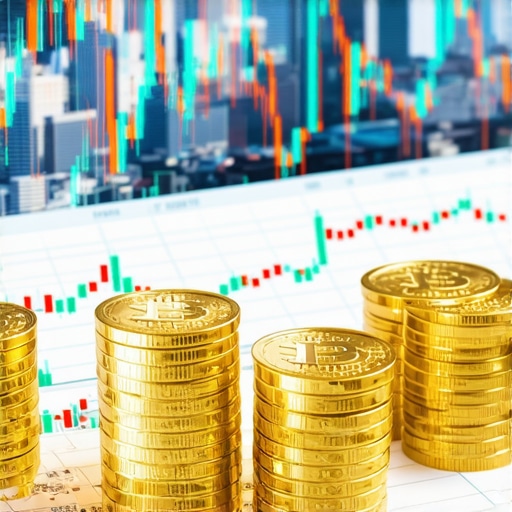Understanding Gold Pricing Trends: A Comprehensive Overview
Gold has long been viewed as a safe-haven asset, attracting investors looking for stability during economic uncertainty. As an investor, understanding the nuances of gold pricing trends is crucial for making informed decisions. In this article, we’ll delve into the factors that influence gold prices and how you can leverage this knowledge to enhance your investment strategy.
The Impact of Economic Indicators on Gold Prices
Gold prices are significantly influenced by various economic indicators, including inflation rates, currency strength, and interest rates. For instance, when inflation rises, the purchasing power of fiat currency decreases, leading investors to seek gold as a protective measure. Consequently, higher demand can drive up gold prices. Additionally, when interest rates are low, the opportunity cost of holding gold diminishes, often resulting in increased investments in this precious metal.
Geopolitical Events and Their Influence on Gold Valuation
Geopolitical tensions can create volatility in financial markets, prompting investors to flock to gold as a safe-haven asset. Events such as wars, political instability, or significant economic sanctions can lead to spikes in gold prices. For example, during times of crisis, the demand for gold typically surges, pushing prices higher as investors seek stability amidst uncertainty.
Understanding Supply and Demand Dynamics
The basic economic principle of supply and demand plays a pivotal role in determining gold prices. When demand exceeds supply, prices tend to rise. Factors such as mining output, central bank purchases, and jewelry demand contribute to the overall supply dynamics. In recent years, the trend of increasing gold purchases by central banks has led to greater demand, which can significantly impact market prices. For a more in-depth look at the underlying factors affecting gold supply and demand, explore our article on gold supply and demand trends.
Strategies for Investors: Navigating Gold Market Trends
For investors, staying informed about gold pricing trends is essential for capitalizing on market fluctuations. This includes monitoring global economic indicators, geopolitical events, and supply-demand dynamics. By understanding these factors, investors can better anticipate price movements and make strategic buying or selling decisions. Additionally, diversifying your portfolio with gold can act as a hedge against market volatility. For guidance on incorporating gold into your investment strategy, check out our post on diversifying your portfolio with gold.
In conclusion, analyzing gold pricing trends requires a multifaceted approach. By recognizing the impact of economic indicators, geopolitical events, and supply-demand dynamics, investors can make more informed decisions in the gold market. As you continue to navigate your investment journey, remember that knowledge is power, and staying educated on these trends will be key to your success.
Technical Analysis: Utilizing Charts to Predict Gold Price Movements
Investors often rely on technical analysis to gauge future gold price movements. This method involves analyzing price charts and patterns to identify trends and potential reversals. Common indicators used include moving averages, Relative Strength Index (RSI), and Fibonacci retracement levels. Understanding these tools can be beneficial for traders looking to time their entries and exits effectively. For a deeper dive into trading techniques, refer to our comprehensive guide on gold trading techniques.
How Currency Fluctuations Affect Gold Valuation
The value of the US dollar plays a significant role in gold pricing. As the dollar weakens, gold becomes more affordable for foreign investors, thereby increasing demand and driving prices up. Conversely, a strong dollar can exert downward pressure on gold prices. Monitoring currency fluctuations, especially in major currencies such as the euro and yen, is crucial for investors who want to understand the broader implications on their gold investments.
Inflation and Gold as a Hedge: Why It Matters
Gold has historically been viewed as a hedge against inflation. As inflation rates increase, the purchasing power of currency diminishes, making gold an attractive alternative. This perception often leads to increased buying activity during inflationary periods, which can further push up prices. For investors looking to protect their wealth against inflation, understanding how gold serves as a financial safeguard is essential. Explore more about this topic in our article on the impact of inflation on gold prices.
Global Demand for Gold: Jewelry, Industry, and Investment
The demand for gold is not solely driven by investment; it also encompasses jewelry and industrial applications. Asian markets, particularly India and China, represent significant consumption of gold, particularly for jewelry. Additionally, advancements in technology have increased gold’s use in electronics and medical industries. By understanding these diverse demand sources, investors can gain insights into long-term trends shaping the gold market. Our piece on gold demand insights provides further information on this subject.
The Role of Central Banks in Gold Prices
Central banks play a pivotal role in influencing gold prices through their monetary policies and gold reserves. When central banks buy gold, it typically signals increased demand and can lead to price surges. Conversely, selling gold reserves can lead to price declines. Monitoring central bank activities, especially in emerging markets, can provide investors with valuable information regarding potential price movements in the gold market. For an analysis of these trends, check out our article on how central bank purchases impact gold prices.
In summary, the intricacies of gold pricing are influenced by a multitude of factors, ranging from economic indicators to global demand dynamics. By staying informed and utilizing a combination of technical analysis and market understanding, investors can navigate the complexities of gold investments more effectively. As you explore your investment options, consider the multifaceted nature of gold pricing and make informed decisions that align with your financial goals.
Geopolitical Events: The Hidden Drivers of Gold Prices
Geopolitical tensions can significantly impact gold prices, as investors often flock to gold during times of uncertainty. Events such as wars, trade disputes, and political instability lead to increased demand for gold as a safe-haven asset. Understanding the correlation between global events and gold prices is essential for investors. For those interested in exploring how global events affect gold prices, our article on analyzing global events’ impact on gold prices offers valuable insights.
The Influence of Interest Rates on Gold Investments
Interest rates play a critical role in the gold market. When interest rates are low, gold becomes more appealing as an investment compared to interest-bearing assets like bonds. Conversely, higher interest rates typically lead to a decline in gold prices, as the opportunity cost of holding non-yielding assets increases. Investors should closely monitor interest rate trends and central bank policies to gauge potential effects on their gold investments.
Gold Supply Chain: Understanding Its Impact on Prices
The gold supply chain is another crucial factor influencing gold prices. From mining operations to refining and distribution, any disruptions in the supply chain can lead to price volatility. Factors such as mining regulations, labor strikes, and natural disasters can impact gold production, affecting availability and pricing. For a comprehensive look at gold supply dynamics, check out our article on understanding the gold supply chain.
Technological Advancements and Their Effect on Gold Demand
Technological innovations have expanded the applications of gold beyond traditional jewelry and investments. Increased use in electronics, medical devices, and renewable energy technologies has created new demand channels. Investors should pay attention to these trends, as they can signal shifts in the overall demand for gold. Our post on gold demand insights delves deeper into these evolving trends.
Investment Trends: Gold ETFs vs. Physical Gold
The choice between investing in gold ETFs or physical gold can significantly influence investor strategies. Gold ETFs provide liquidity and ease of trading, appealing to many modern investors. However, physical gold offers tangible value, attracting those who prefer a more traditional approach to wealth preservation. Understanding the pros and cons of each investment type is vital for making informed decisions. For an in-depth analysis, refer to our article on physical gold vs. gold ETFs.
In conclusion, the dynamics of gold pricing are influenced by a myriad of factors, including geopolitical events, interest rates, supply chain complexities, and technological advancements. By staying informed about these elements, investors can better navigate the gold market and make strategic investment choices. As the landscape continues to evolve, understanding these factors will be crucial for long-term success in gold investing.
Understanding Gold Investment Strategies: Key Insights for Investors
As gold continues to be a popular investment option, understanding various gold investment strategies is essential for both novice and seasoned investors. With the evolving market dynamics, keeping abreast of these strategies can enhance your portfolio’s potential returns. Investors should consider the types of gold investments available, including physical gold, gold ETFs, and gold mutual funds. Each option presents unique advantages and risks that can affect overall investment performance.
Physical Gold: A Tangible Asset for Wealth Preservation
Investing in physical gold remains a favored choice for many due to its intrinsic value and historical significance as a safe haven during economic downturns. Whether it’s gold coins, bars, or jewelry, physical gold provides a sense of security that digital investments cannot match. However, it is essential for investors to understand the costs involved in purchasing and storing physical gold. For comprehensive insights, explore our article on the ultimate guide to buying physical gold.
Gold ETFs: Accessibility and Flexibility
Gold Exchange-Traded Funds (ETFs) offer a more accessible way to invest in gold without the hassle of storage and security associated with physical gold. These funds track the price of gold and can be traded like stocks, providing liquidity and ease of access. Investors should evaluate the management fees and the underlying assets of the ETFs they consider to ensure they align with their investment goals. For more details on the pros and cons of different gold investments, visit our article on physical gold vs. gold ETFs.
Gold Mutual Funds: Diversification Within Your Investment
Gold mutual funds allow investors to pool their resources into a diversified portfolio of gold-related securities, including mining stocks and ETFs. This strategy can potentially reduce risk while providing exposure to the gold market. Understanding the performance of the underlying assets and the fund’s management style is crucial before investing. For a deep dive into gold mutual funds, check out our post on investing in gold mutual funds.
Assessing Market Trends for Informed Decisions
Staying informed about current market trends is vital for making strategic gold investments. Factors such as inflation, currency fluctuations, and geopolitical events can influence gold prices significantly. Investors should employ analytical tools and market research to assess these trends regularly. Our article on gold market analysis provides insights into key indicators to consider.
Conclusion: Crafting a Strategic Gold Investment Approach
Developing a well-rounded gold investment strategy involves understanding the various investment types, market conditions, and personal financial goals. By diversifying your investments through physical gold, gold ETFs, and mutual funds, you can navigate the complexities of the gold market effectively. As we look into 2025 and beyond, equipping yourself with the knowledge of market trends and investment options will serve you well in achieving your financial objectives in gold investing.
Frequently Asked Questions About Gold Investment
What are the main types of gold investments?
The main types of gold investments include physical gold (coins, bars, and jewelry), gold ETFs (exchange-traded funds), and gold mutual funds. Each type offers distinct advantages and can suit different investment strategies and risk tolerances.
Is investing in physical gold a good idea?
Investing in physical gold is often considered a safe haven during economic uncertainty. It provides intrinsic value and can act as a hedge against inflation. However, it comes with costs for purchasing and storing, which investors should consider.
How do gold ETFs work?
Gold ETFs are investment funds that track the price of gold. They can be traded on stock exchanges like regular stocks, making them a convenient option for investors seeking exposure to gold without the need for physical storage.
What are the tax implications of investing in gold?
The tax treatment of gold investments varies by country. In many jurisdictions, physical gold is subject to capital gains tax, which is applicable when the asset is sold for a profit. It’s advisable to consult with a tax professional to understand the implications for your specific situation.
What factors influence gold prices?
Gold prices are influenced by various factors, including inflation rates, interest rates, currency strength, and geopolitical events. Understanding these factors can help investors make informed decisions about when to buy or sell gold.
How can I diversify my gold investments?
Diversifying your gold investments can be achieved by combining physical gold with gold ETFs and mutual funds. This strategy can help mitigate risks while providing exposure to different segments of the gold market.
Are gold mutual funds a safe investment?
Gold mutual funds can provide diversification and professional management, which may reduce risks compared to investing in individual stocks. However, like all investments, they carry risks and should be selected based on research and alignment with personal financial goals.
How can I analyze gold market trends?
Analyzing gold market trends involves monitoring economic indicators, geopolitical events, and market sentiment. Using analytical tools and resources, such as financial news and market reports, can help investors stay informed about potential price movements.
What is the best time to buy gold?
The best time to buy gold typically depends on market conditions, individual financial goals, and investment strategy. Monitoring market trends and economic indicators can help identify favorable buying opportunities.
Authority Resources for Gold Investment Information
For those looking to deepen their understanding of gold investments, here are some trusted resources and websites:
- Investopedia: Gold Investment Guide – Provides comprehensive information on gold investments, including definitions and strategies.
- Kitco News – A leading source for precious metals market news, analysis, and price information.
- World Gold Council – Offers insights on gold’s role in investment portfolios and economic trends.
- BullionVault – A platform for buying, selling, and storing physical gold with expert insights and market analysis.
- Morningstar – Provides research and analysis on gold mutual funds and ETFs, helping investors make informed decisions.
Conclusion: Navigating the Gold Investment Landscape
In summary, understanding the various gold investment strategies, market trends, and personal financial goals is crucial for successful investing in gold. By considering options like physical gold, gold ETFs, and mutual funds, and staying informed through trusted resources, you can construct a robust gold investment strategy. As the gold market continues to evolve, equipping yourself with knowledge will ensure you are well-prepared to achieve your investment objectives.










